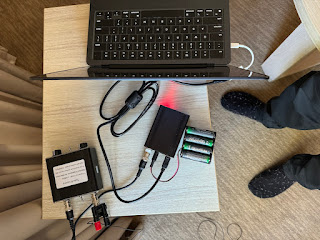This year I fulfilled a long term ambition of visiting Uluru in the centre of Australia and I couldn’t help thinking how spots from there might look on a WSPR map. Here's a spoiler (plotted in WSPR Watch):
Operating QRP from a motel room is a challenge in several respects. From past experience I knew that receive noise would be high and while it’s possible to hang an antenna up inside the room, getting it out on a balcony would work much better. The motel at Yalara (where the accomodation is near Uluru) had a decent but all metal balcony.
The first attempt had the wire antenna on the outside face of the balcony. Reception and transmission was not good. Our room was on the second floor and there was a small tree just across a path so a sugar packet was tied to the end of the wire for a bit of weight and I threw it out to the tree. This worked much better.
The end fed wire was cut randomly and is about 4m in length (very short for the 20m band). A small counter-poise of about 1.5m was just laid out on the floor. A QRP Z-match antenna tuner was used and a NanoVNA was used for initial tuning. The Z-match was able to provide a very good match, no external Unun was needed. No doubt there are losses but my signal was received around the world so they can't be too bad.
The Z-match has an SWR indicating LED (you tune for minimum brightness) but I also experimented with a simple RF current detector and found that brightness is maximum close to when the SWR is at a minimum.
There’s promise in this simple RF current detector and in an absolute miniature equipment setup I might opt for one of these combined with receive noise peaking to indicate antenna resonance.
Having said that, the NanoVNA is a remarkable piece of pocket sized test equipment, smaller than any antenna analyser and very capable.
Weak signal operation in a poor location begs for WSPR operation and the rig of choice for me is the QRP-Labs QDX which has many advantages including being pocket sized. I powered it from a block of 8 AA NiMH batteries which were able to run it from about 6pm until 3am local time with 10% transmission.
WSJT-X was run on an M2 MacBook Air prevented from sleeping with the Caffeinated app. One of the benefits of using the QDX is that rather than mixing WSPR audio tones up to SSB audio, Hans cleverly measures the period of the audio cycle and directly sets the RF oscillator to the right frequency. This makes for a very pure transmitted signal and I’m convinced that WSPR transmitted by one of Hans’ recent transceivers is more easily decoded than the same power from a sideband transmitter.
One 2 minute transmission was reported by 41 stations which is pretty good going given my remote location and compromise antenna.
In this case my end fed wire antenna was black insulated hookup wire. It was not easy to spot from outside and I know that some stations use wire-wrap wire which is virtually invisible even close by.
If you ever get the chance to visit Uluru, go for it. It’s a remarkable feature of the landscape.
If you will be in a motel anywhere in the world consider digital QRP operation.








1 comment:
Your RED Led on the torrid is simple beauty. I made a crystal radar radio with a Russia’n $8 1964 10 ghz diode with a 3” paperclip dipole on the adc of an Esp32 - AI Thinker cam, summing the voltage seen, blinking a blue led, watching for ship radar in the 800’ wide cape cod canal an hour south of Boston to shoot boat pictures. Fun tricks.!
I made a real crystal radio with iron pyrite, fools gold and a safety pin and a toilet paper tube wire coil, in Milwaukee in 1956 with an antenna wire on a kite and likely proved the existence of God, as I didn’t meet him that day.
Post a Comment